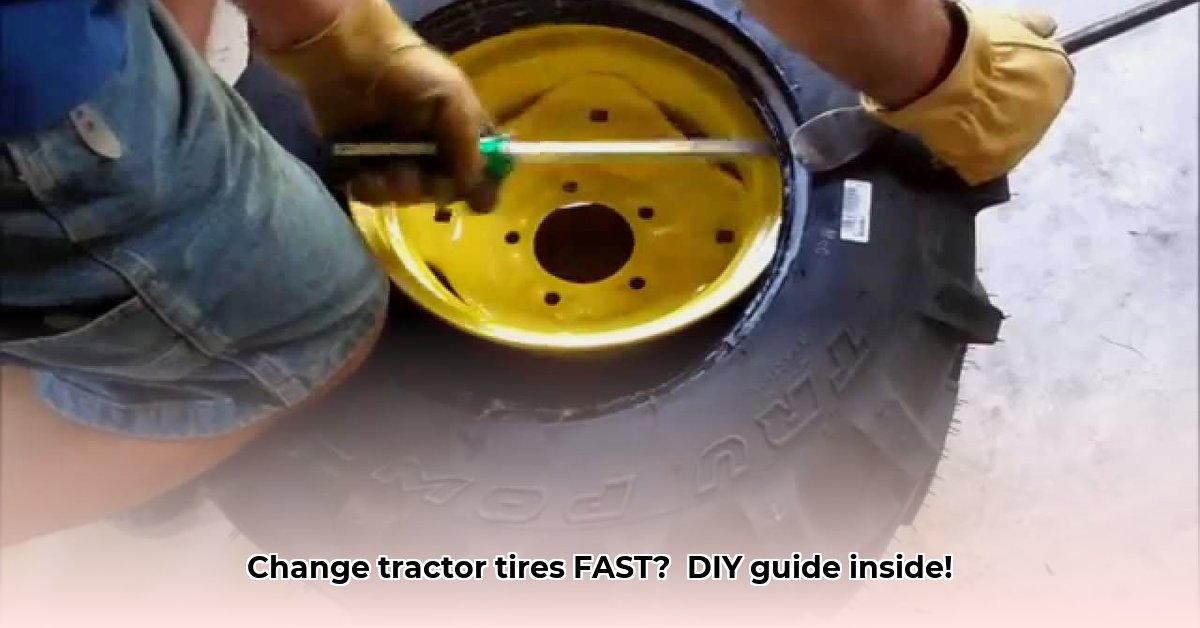
Safety First: Protecting Yourself and Your Equipment
Before you begin, prioritize safety. This involves more than just careful handling; it's about preventing serious injury. Remember, you're working with heavy machinery and potentially high-pressure air. Finding the right tire can be crucial; check out tractor tire prices before you begin.
- Eye Protection: Always wear safety glasses or goggles to protect against flying debris. This is non-negotiable.
- Gloves: Thick work gloves protect your hands from cuts, scrapes, and punctures.
- Stable Surface: Ensure your tractor is on a level, stable surface. Improper jacking can lead to serious accidents.
- Jacking Points: Use your tractor's designated jacking points (consult your owner's manual).
- Wheel Chocks: Securely wedge wheel chocks behind the wheels that remain on the ground to prevent the tractor from rolling.
- Air Pressure: Deflate tires completely before handling them. Inflate slowly and monitor pressure closely to avoid overinflation.
- Never Work Alone: Always have a helper present. Having an extra pair of hands improves efficiency and safety.
Tools and Materials: Gearing Up for the Job
The necessary tools vary depending on the tire type: tube, tubeless, or spindle mount.
All Tire Types:
- Jack (suitable for your tractor's weight)
- Lug wrench
- Wheel chocks
Tube-Type Tires:
- Tire irons (at least three)
- Air compressor
- Tube patches (if repairing)
Tubeless Tires:
- Tire mounting tools (bead breaker, tire spoons)
- Bucket of soapy water
- Air compressor
- Lubricant (silicone-based)
Spindle Mount Tires:
- Spindle nut wrench
- Possibly a specialized puller
- Penetrating oil (for stubborn bolts)
- Impact wrench (recommended)
Step-by-Step Instructions: Changing Your Tractor Tire
Changing a Tube-Type Tractor Tire
- Complete Deflation: Fully deflate the tire for safety and easier handling.
- Secure Jacking: Carefully jack up the tractor, ensuring stability at the correct jacking point.
- Lug Nut Removal: Use the lug wrench to remove the lug nuts and store them safely.
- Wheel Removal: Remove the wheel.
- Tube Examination: Remove the tire using tire irons, inspect the inner tube for damage, and repair or replace as needed.
- New Tube Insertion: Carefully insert the new or repaired tube into the tire, ensuring it's not twisted.
- Tire Remounting: Seat the tire onto the rim, using soapy water to aid the process.
- Inflation: Slowly inflate the tire, monitoring pressure and ensuring proper bead seating.
- Wheel Reinstallation: Reinstall the wheel and tighten the lug nuts.
- Lowering the Tractor: Slowly lower the tractor, double-checking everything is secure.
Changing a Tubeless Tractor Tire
- Deflation: Fully deflate the tire.
- Jacking and Wheel Removal: Follow steps 2-4 from the tube-type instructions.
- Tire Removal: Use a bead breaker and tire spoons to carefully remove the tire from the rim. Soapy water helps immensely.
- Rim Inspection: Inspect the rim before installing a new tire.
- New Tire Installation: Carefully mount the new tire, using lubricant and soapy water.
- Inflation and Seating: Slowly inflate the tire, ensuring the beads seat correctly. You might need to manually assist.
- Reinstallation and Lowering: Follow steps 9-10 from the tube-type instructions.
Changing a Spindle-Mount Tire
This process is more complex and requires specialized tools and expertise. Consult your tractor's manual or seek professional help. Improper handling can cause damage.
Troubleshooting: Addressing Common Issues
- Stubborn Tires: Use more soapy water or lubricant. Don't force it; this can cause damage.
- Damaged Rims: Repair or replace damaged rims immediately; they are a safety hazard.
- Tool Malfunctions: Ensure your tools are in good working order before you start.
Responsible Tire Disposal: Protecting the Environment
Dispose of old tires responsibly. Check with your local waste management facility or tire shops for recycling options.
Conclusion: A Successful Tire Change
Changing a tractor tire is achievable with the right approach and safety precautions. Remember: patience, careful attention to detail, and the right tools are key to a successful and safe operation. If you encounter any difficulties or are unsure of any step, consult your tractor's manual or seek professional help. Don't compromise on safety.